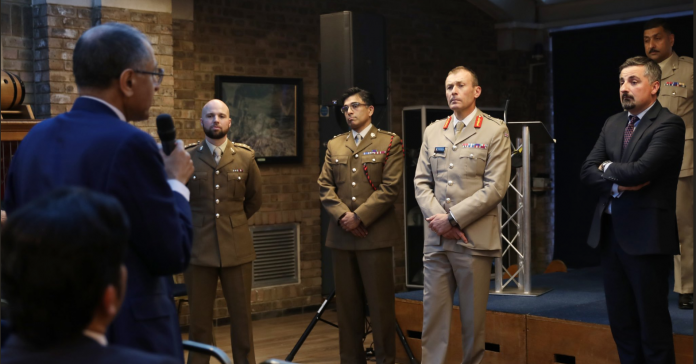Written by Dr Ziya Meral
This work is strictly the view of the author, not the British Army and Ministry of Defence.
When we launched the Global Analysis Programme (GAP) at the CHACR a little more than 3 years ago, the vision behind it was clear: the world was fast-changing and, as the world changed, so too did the current and future operating environment. We had to make sure that the Army (and wider Defence) personnel kept up-to-date with key developments in the world and that they had the opportunity to engage with leading experts, and so to expand their own horizons and strategic awareness.
The pandemic has provided the CHACR team with some time to reflect upon what the GAP has done in pursuit of that vision, and to consider what lessons it can teach on how the Defence community can engage with external experts. At the same time, we have been able to think about how we may be better able to create spaces for people to think and reflect on a range of issues, especially in terms of engagement with different perspectives. The first question below lists all of the major activities of the GAP to be able to provide an overview of what it has done. Do feel free to fast read this first bit, before the next headings which reflect on what worked and what did not, and, of course, on what we need to do better.
What events and products work?
As I say above, you may wish to skip through this section rapidly! It’s not designed to blow our own trumpet, but it was well worth pausing for just a short while to reflect upon the sheer volume and variety of what we have bombarded the Army with over the last three years, or so, in our bid to meet our remit to “develop and sustain the Army’s conceptual component of fighting power”. And remember, as you wade through the list of events, publications and products set out below, that the GAP represents just one-third of what we are structured to deliver across the CHACR.
When we first launched Lecture Events at the Royal Military Academy Sandhurst, there was some scepticism that personnel from a busy Army and wider MoD community would have the time to commute to and attend such events, especially those that take couple of hours. The same could be said for speakers, who might not want to do the fascinating and convoluted train journey to Camberley. I am happy to reflect back on almost 20 such lecture events that we organised just within the GAP, featuring well-established experts and speakers on a broad range of topics, including: the Dark Net (Jamie Bartlett); Open Source Investigations (Eliot Higgins); Negotiating With Armed Groups (Samir Puri); Reading and Understanding Clausewitz Today (Prof Christopher Coker); Nuclear Arms Control (Heather Williams); Changing Energy Politics (Mehmet Ogutcu); The Arab World Today (HA Hellyer); The Future of Iraq (Mina Al-Oraibi);Russian Active Measures (John Sipher); National Intelligence and Military Operations (Douglas Wise); ISIS (Hassan Hassan); Turkey Under 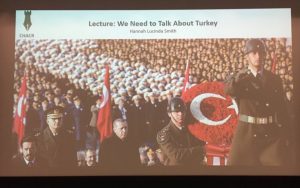 Erdogan (Hannah Lucinda Smith); Northern Ireland and the border issues (Katy Hayward) and Information in Conflict Zones (David Patrikarakos). On average some 300 Army officers and soldiers attended each of these lectures, some of them saw 650 people attending, and only couple saw smaller audiences of 150 to 200 personnel attending (largely due to calendar changes and challenges); and many more people have watched the recordings of these lectures on the AKX. The audience almost always included the full spectrum of the ranks from four-star generals, to young officers fresh out of Sandhurst, as well as a good spread of Junior and Senior NCOs.
Erdogan (Hannah Lucinda Smith); Northern Ireland and the border issues (Katy Hayward) and Information in Conflict Zones (David Patrikarakos). On average some 300 Army officers and soldiers attended each of these lectures, some of them saw 650 people attending, and only couple saw smaller audiences of 150 to 200 personnel attending (largely due to calendar changes and challenges); and many more people have watched the recordings of these lectures on the AKX. The audience almost always included the full spectrum of the ranks from four-star generals, to young officers fresh out of Sandhurst, as well as a good spread of Junior and Senior NCOs.
The lecture events have been interspersed with half-a-dozen Panel Discussions, that included 3 to 4 speakers and a Chair, focusing on a variety of topics, with audience sizes of 300 to 500. For example, our ‘Syria: What is Next?’ panel included discussions on Kurdish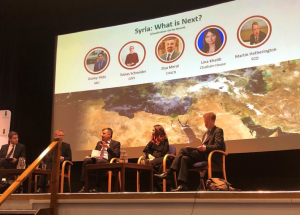 groups in NE Syria (Guney Yildiz), the Syrian economy (Tobias Schneider), regional actors (Lina Khatib) and implications for the UK (Martin Hetherington). The panel on Iran included Ambassador Nicholas Hapton (former UK envoy to Tehran) and Aniseh Tabrizi, and the panel that focused on escalation with Iran after the Qassim Soleimani strike included an overview of Iran (Dina Esfandiary), regional fall out (Emile Hokayem), Israel and US policies (Michael Stephens) and UK responses (Sir Peter Westmacott).
groups in NE Syria (Guney Yildiz), the Syrian economy (Tobias Schneider), regional actors (Lina Khatib) and implications for the UK (Martin Hetherington). The panel on Iran included Ambassador Nicholas Hapton (former UK envoy to Tehran) and Aniseh Tabrizi, and the panel that focused on escalation with Iran after the Qassim Soleimani strike included an overview of Iran (Dina Esfandiary), regional fall out (Emile Hokayem), Israel and US policies (Michael Stephens) and UK responses (Sir Peter Westmacott).
We have also organised Study Days which have featured 4 to 6 speakers, providing in-depth presentations on an issue or country of focus, to around 70 personnel that work directly on the issues. The one on China, which explored whether the country is ‘a friend, or a foe, or neither’, featured presentations from Prof Kerry Brown, Prof Steve Tsang, Dr Yu Jie, Bobo Lo, and Raffaelo Pantuci, as well as papers by other experts like Bill Hayton and Meia Nouwens, all of which were brought together in a special edition of CHACR’s Ares & Athena series. There were also a limited number of Round Table Discussions that provided chances for Army personnel to discuss a specific topic more frankly with experts in a small group. These have included, for example, one on escalation between Saudi Arabia and Turkey with Jane Kinninmont, and one on intelligence and military operations with Douglas Wise.
There were also two events organised with partners that included elements of all of the above. The GAP organised a roundtable discussion for 40 attendees on UK-US military relationship and the Transatlantic Alliance, bringing UK personnel together with their US peers from the Modern War Institute based at West Point, all of which was followed by a lecture given by Major John Spencer of the MWI on Urban Warfare, which saw more than 500 attendees. A day-long event that was jointly organised with the HMG Euro-Atlantic Security Policy Unit on the challenges facing NATO today saw some 400 people from across all of the UK government departments, from the Cabinet Office, FCO, Home Office, Metropolitan Police as well as the Royal Navy and Royal Air Force. This event consisted of two panel discussions featuring speakers such as Sir David Omand, James Ker-Lindsay, Peter Neumann, Constanzse Stelzenmuller, Andrew Monaghan, Prof Malcolm Chalmers, Sir Gen James Everard and Angus Lapsley. The afternoon session saw a more detailed and frank discussion, with a select audience of some 70 senior UK defence, security and foreign policy officials discussing NATO and UK contributions with Ambassador Sarah MacIntosh as the chair. The day’s discussions were published as an edition of Ares & Athena.
all of the UK government departments, from the Cabinet Office, FCO, Home Office, Metropolitan Police as well as the Royal Navy and Royal Air Force. This event consisted of two panel discussions featuring speakers such as Sir David Omand, James Ker-Lindsay, Peter Neumann, Constanzse Stelzenmuller, Andrew Monaghan, Prof Malcolm Chalmers, Sir Gen James Everard and Angus Lapsley. The afternoon session saw a more detailed and frank discussion, with a select audience of some 70 senior UK defence, security and foreign policy officials discussing NATO and UK contributions with Ambassador Sarah MacIntosh as the chair. The day’s discussions were published as an edition of Ares & Athena.
The annual Making Sense of a Confusing World Conference brought every year of the GAP to an end in December with some four panels taking place at Sandhurst to an audience of around 650 Army personnel, covering a broad range of global issues. The Conference always ends with a panel discussion on the implications for the Army, featuring senior Army leaders such as the Commander Field Army, Commander Home Command, Director Land Warfare and Head Army Strategy. The keynote speakers included author Tim Marshall and the defence editor of the Economist, Shashank Joshi, with experts in the panels including Gordon Carrera, Sinan Ulgen, Raffaelo Pantuci, Ali Ansari, Mark Galeotti, Anthony King, Leslie Vinjamuri, Rym Momtaz, Jason Mosley, Hans Kundani, Nicholas Van Hear, Aliide Naylor, Tom Hashemi, Elisabeth Braw and Georgina Wright. The first two conferences received tremendous feedback, and we hope that the pandemic conditions will allow us to end the year with another one in December 2020 (even if we have to achieve it virtually)!
audience of around 650 Army personnel, covering a broad range of global issues. The Conference always ends with a panel discussion on the implications for the Army, featuring senior Army leaders such as the Commander Field Army, Commander Home Command, Director Land Warfare and Head Army Strategy. The keynote speakers included author Tim Marshall and the defence editor of the Economist, Shashank Joshi, with experts in the panels including Gordon Carrera, Sinan Ulgen, Raffaelo Pantuci, Ali Ansari, Mark Galeotti, Anthony King, Leslie Vinjamuri, Rym Momtaz, Jason Mosley, Hans Kundani, Nicholas Van Hear, Aliide Naylor, Tom Hashemi, Elisabeth Braw and Georgina Wright. The first two conferences received tremendous feedback, and we hope that the pandemic conditions will allow us to end the year with another one in December 2020 (even if we have to achieve it virtually)!
All of these live events are supplemented by two kinds of regular publications, which have spread far and wide, not just within UK Defence, but across our NATO allies and into academia. The GAP has produced to date some 21 In Depth Briefings (2000 to 3000 words long briefings, on a specific issue or development), written by some of the speakers 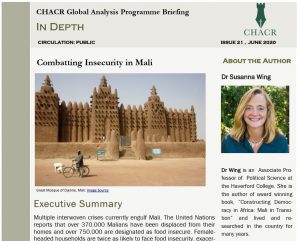 mentioned above, and long list of others, on a broad range of issues: negotiations with North Korea; developments in Libya; North East Syria; detained ISIS militants; Russian use of religion in diplomacy; the Cyprus peace talks; the Turkish invasion of North East Syria; Russian activities in the Balkans ; and insecurity in Mali, to name but a few. Most were not released publicly, but only shared within the Defence community, and have proved to be very welcome as they provide accessible and short analysis of ongoing developments. Similarly, the GAP has produced biweekly and monthly newsletters, which have been forwarded widely, and have included reviews of articles, books, podcasts, essays and news developments of which the Army should be aware. I also managed to release on a book on religion and conflict in Africa and the Middle East and got interviewed by a broad range of media outlets on global developments including the New York Times, the Economist, the Times, the Daily Telegraph, the Atlantic and live interviews on BBC World, Al Jazeera, MSNBC and France 24.
mentioned above, and long list of others, on a broad range of issues: negotiations with North Korea; developments in Libya; North East Syria; detained ISIS militants; Russian use of religion in diplomacy; the Cyprus peace talks; the Turkish invasion of North East Syria; Russian activities in the Balkans ; and insecurity in Mali, to name but a few. Most were not released publicly, but only shared within the Defence community, and have proved to be very welcome as they provide accessible and short analysis of ongoing developments. Similarly, the GAP has produced biweekly and monthly newsletters, which have been forwarded widely, and have included reviews of articles, books, podcasts, essays and news developments of which the Army should be aware. I also managed to release on a book on religion and conflict in Africa and the Middle East and got interviewed by a broad range of media outlets on global developments including the New York Times, the Economist, the Times, the Daily Telegraph, the Atlantic and live interviews on BBC World, Al Jazeera, MSNBC and France 24.
All of the GAP products and events have spread their reach as I prioritised speaking directly to Army units and wider HMG organisations across the UK, and internationally,  with a set talk on global trends in Defence, and conflicts and security. The talk and debate format has become a fixed item after more than a dozen JOTAC and JSCSL courses, reaching out to more than 2000 young officers across the Army, and a similar number of talks were delivered all across the Army including talks to forces based in Scotland and Cyprus and into the Royal Marines and joint forces and operations. Some 30 talks later, I suspect most young officers in the Army have heard me making the same jokes, but most have also expressed a genuine interest in why we should be discussing strategic events and shocks at all levels and in bridging the gap between expertise and practice.
with a set talk on global trends in Defence, and conflicts and security. The talk and debate format has become a fixed item after more than a dozen JOTAC and JSCSL courses, reaching out to more than 2000 young officers across the Army, and a similar number of talks were delivered all across the Army including talks to forces based in Scotland and Cyprus and into the Royal Marines and joint forces and operations. Some 30 talks later, I suspect most young officers in the Army have heard me making the same jokes, but most have also expressed a genuine interest in why we should be discussing strategic events and shocks at all levels and in bridging the gap between expertise and practice. 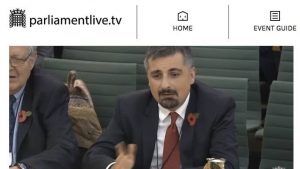 And this does not include a similar number of talks that I have given on a broad range of external platforms, including the FCO, HoC Foreign Affairs Committee, US State Department, West Point and leading universities and think thanks in the UK and around the world.
And this does not include a similar number of talks that I have given on a broad range of external platforms, including the FCO, HoC Foreign Affairs Committee, US State Department, West Point and leading universities and think thanks in the UK and around the world.
With the pandemic lockdown, all of these activities shifted to the virtual world with the GAP kicking off CHACR Take Away Video interviews with leading experts to provide 25-mins-long videos and podcasts, as well as CHACR Lectures on the Go with leading experts offering 35-mins-long talks on issues such as Russian activities in Eastern Europe, the background to the Cyprus peace talks, and the GCC crisis with Qatar. We have already released 15 of them, and kicked off a new Webinar series. The first Webinar featured Angus Lapsley, DG Strategy and International at the MoD, with some 350 people dialling-in directly and some regiments and units watching it together in large groups. We have tried to help Army personnel to keep learning and thinking while working remotely.
So, the GAP has been a busy initiative that has so far facilitated almost 100 experts speaking and writing for the Army, a significant proportion of whom had never engaged with the Army before, and whose voices and insights and backgrounds go way beyond the established channels and platforms that we normally turn to for information. And from the feedback that we have received from across the Army, you have enjoyed and benefited as much from these sessions and products as I have.
What lessons can we learn from the GAP?
First of all: it works! Engaging with external experts, providing a platform for them to share their insights, and for Army and Defence personnel to learn from them, is clearly welcomed by both worlds! We paid a modest fee to all the experts who spoke in our events and/or wrote for us, on principle and out of respect for their time and work, but almost all would have done so without financial reward. They valued the opportunity, were delighted to see the RMAS campus, and absolutely all of them expressed how they found engaging with the Army fascinating and helpful, and observed that their audiences insightful and receptive beyond their expectations. Many of them subsequently went on to speak at other Army events as a result of this introduction. Army personnel, too, have continued to give us very positive feedback on the value of meeting the authors that they read or see on television, and of being exposed to experts that they did not know about at all, but now intend to follow.
Second: it is difficult to measure impact and outcomes, but it has been highly cost-effective. For those who like charts and numbers to measure effect and value against cost, we can only provide a breakdown of the thousands of people who attended the events and the number of speakers and briefings and their spread, and the anecdotal feedback we get from them. Beyond that, we can only provide an instinctive inference that the GAP has contributed to the tasking of CHACR to enhance the conceptual component of fighting power. The fact that the GAP activities lead to so many lecture and briefing requests, from all points from regiments to Army HQ, reflects how the GAP has emerged as a valued resource for our main consumer. But it has also provided the Army with a defence engagement tool that interacts with highly influential experts and international and UK government institutions. The cost of all of these activities alongside the honorariums paid to experts have been truly humble, and substantially less than the costs of similar events and commissioned studies at leading think tanks in London, Washington, Paris and elsewhere, or offered by consultancy firms and universities.
Third: it is difficult to balance the strategic conversations with operational requirements. The Army has been increasingly forward-leaning in asking for events and products. To start with, most GAP events and products were initiated by me, looking at global developments and the Army portfolio, and assessing the topics and issues with which personnel were engaging, or were not engaging with directly at work but of which they ought to be aware. Some were directly requested, tasked or intentionally aligned with operational requirements and key developments. Doing large events at Sandhurst meant that some people whose work directly related to the topic could not attend them physically. At the same time, conversely, some people whose work did not relate directly to the discussion, but who saw attendance as a PME opportunity, were able so to do. Providing only operationally relevant content would have been limiting, while providing only strategically interesting topics would have made our activities a luxury. The formula on how to balance this is yet to be fine-tuned, and I suspect will never be (and, perhaps, ought not to be) resolved if we want to both ‘support’ but also ‘challenge’ and ‘point to’ things that may otherwise slip by unobserved and undiscussed.
Fourth: it needs to diversify its products and expand its reach and work. Providing more video and audio content have always been an ambition, and an acknowledged short-coming for the GAP. Interestingly, the pandemic provided the space to shift towards such products as travel and mass-attendance events stopped. The challenge will now be to continue offering personal engagement while continuing productions that enables the wider Army, and Defence, to learn and engage, such as video recordings, podcasts and webinars. The event locations need to vary further, not remain so heavily focused near our offices in Robertson House on the RMAS site. External partnerships with allied militaries and wider HMG, and with British universities and think-tanks, and with NGOs and more unusual organisations from an Army perspective, need to be managed and pursued intentionally rather than emerging as ad-hoc opportunities. All of this would require the GAP to evolve from a one-man band supported by admin muscle-power to a team of effective and driven practitioner-scholars and interested soldiers who are driven by the same vision and passion.
Personally, reflecting back upon what the GAP has achieved over the last three years, I can honestly say that this has been one of the most truly rewarding and truly exciting professional experiences of my very varied career. It has set up new paths between the Army and external expertise and information outlets, triggered new friendships and partnerships, and challenged a lot of preconceptions and even prejudices that people had from all shades of the spectrum. I have found it particularly rewarding to feel that I may have been able, in my own way, directly to help our men and women heading out deployments, handling demanding tasks and even just wanting to study for a masters or a doctoral degree and needing some help, friendship and feedback. So, I can say it has been a true honour and privilege to serve in this space and I am only excited by the prospects of how we can develop this kind of engagement in 2021 onwards. Thank you for giving me the chance, and for joining in, so enthusiastically, on the journey with me.


